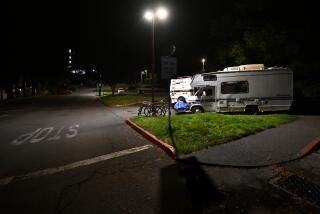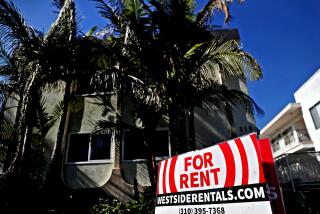Column: He just wants a job that will pay the rent, but he’s getting scared

Todd Little says the rent on his Toluca Lake one-bedroom apartment is covered through February. Credit cards might keep him in place through March, but beyond that, unless he finds work soon, he doesn’t know where he’ll end up.
Homeless, perhaps?
“It’s a possibility,” Little said over a Tuesday morning cup of coffee at a diner in Studio City.
Last year, I wrote a lot about homelessness and it’s still an important issue. This year, though, I’ve been thinking I also want to take a closer look at the millions of Californians who still have roofs over their heads but are barely hanging on, despite living in a state with the world’s fifth-largest economy.
And then, as if on cue, I heard from Little, whom I first met 10 years ago.
“50 Something and Faking Normal,” said the message field in an email Little wrote to friends and colleagues.
“It’s the start of a new year and as many of you know, I have been applying and interviewing for jobs in several capacities to no avail,” he wrote.
Little said he wondered if being middle-aged was working against him, and he asked for any and all leads on temporary work and odd jobs while he continued his search for solid, full-time employment.
I met Little in 2010, when unemployment in California was peaking during the recession. He was an unemployed 45-year-old who’d graduated in theater design and directing from Pitzer College and was getting more desperate by the day, having to make regular visits to a West L.A. food pantry. When I checked in a few months later, he’d gotten a job in retail, but wasn’t much better off. His long commute to a low-wage job had him cutting back on everything, including food, clothing, household cleaning supplies and even lightbulbs.
Then Little landed a good job with a home decor company. For almost eight years, the pressure was off, with one catch. He got evicted from the home he was sharing in West Hollywood when it was pulled off the rental market by the owner, but with a steady income, he found a similar setup in Toluca Lake.
The good times came to an end last spring, when his employer closed the store Little managed because of tough competition from online providers. Little found another job briefly, but said it was a bad fit from the beginning. He collected unemployment temporarily, but now he’s living on modest savings and credit cards he’d rather not use.
Little said he doesn’t go out to eat. He has no cable. He clips coupons before he shops for the groceries he stretches for a week. He avoids outings with friends because he doesn’t want to be a charity case.
“I still feel like someone else needs a handout more than me,” said Little, who didn’t even want to send out the email about his predicament, but was pushed by a friend.
It’s not that Little can’t find work; it’s that he can’t find a job with a living wage. He uses a gaggle of job search sites and fills out a couple of applications a day, usually online, which can feel like a journey through virtual trapdoors.
“You might get to where they say they have a few more questions, so you click on this link, you go through another screening to where you’re asked if you’re willing to work 24-7, and this job pays $13.25 an hour are you OK with that, and will you be available for 20 to 30 hours a week, but basically it’s 20 because that’s how they start you, and if you say yes to all that you click to a link that brings you to interview scheduling,” Little said.
But if an interview time doesn’t work, maybe because you had another interview that day, you’re out of luck.
Little said he got as far as an in-person chat with a drugstore manager, who handed him off to an assistant manager for an interview.
“It’s for a part-time job, less than 20 hours, at $14.25 an hour, which doesn’t work unless you’re living in a house with family and everyone else is helping to pay the rent,” Little said. “She was a lovely girl, but I could have been her father, and that’s a lot of the problem. The hiring managers are all half my age, or maybe three-quarters.”
Little thinks in a lot of cases, those managers might fear he’ll take their jobs, or that a well-spoken middle-aged college graduate like him will leave as soon as he finds a better job. Some friends have advised him to take any job, just to have one. Others have advised him not to panic, and spend all his time focused on landing the right job.
Little has stopped putting his age, his three decades of work experience and the year of his college graduation on his resume and applications for fear all that will work against him.
He could take in a roommate, but he’s trying to hold off on that. He could move to an area with a cheaper cost of living, but he wouldn’t have any social or job connections in such a place, and wages might be even lower. He could drive for Uber, but his 2006 Ford Explorer, with 148,000 miles, isn’t a particularly smooth ride or economical option.
Little wants a real job and has to believe he’ll find one, eventually. But his story is a reminder of how misleading the rosy economic statistics can be at a time of mind-boggling income inequality.
“The U.S. economy and the California economy are growing and the unemployment rate is low, but the growth is skewed away from manufacturing and many traditional jobs, and when you have that kind of transformation … there is serious dislocation,” said Jerry Nickelsburg, director of the UCLA Anderson Forecast.
Tech is a good field for solid job prospects going forward, Nickelsburg said, but retraining can be challenging in multiple ways for older generations.
“If you were, for example, in your 50s and you went to school for a year to gain some new skills, you’re still in your 50s,” Nicklesburg said. “It’s much harder to make it worthwhile even if you get a job, and it’s going to be harder to convince an employer you can be a long-term employee they should invest a lot of money in.”
Little would prefer a job in which he helps companies build customer relations, but he’s open to just about any line of work and has applied at Home Depot and at various retail goods start-up companies. His problem, like those of so many other Californians, is not just that wages are low, but that housing costs are so high.
“The housing boom is clustered in these coastal regions and housing costs are growing faster than wages are, especially at the bottom,” said Julien Lafortune of the Public Policy Institute of California. “It’s harder and harder to keep up each year.”
Just under 40% of the California population is at or near the poverty level when the cost of living is factored in, said Lafortune, who was one of the researchers on a just-released report that said California’s strong economy has “underlying economic realities” that don’t look so good.
Over coffee, Little and I looked over some of that report together.
Nearly 2 million Californians ages 25 to 64 were working but living in poverty in 2017.
Median annual earnings for white and Asian families were $115,000 in 2018, while they were just $66,000 for African Americans and $60,000 for Latinos.
Since 1980, the median middle-income family is doing 24% better, but the median high-income family is doing 50% to 60% better.
And the top 10% of families make more than 10 times as much as the bottom 10%, a multiple that has doubled since 1980.
“That’s astounding,” Little said. “I hear about numbers like these all the time, and I wonder what happened to the middle class. Where did it go?”
More to Read
Start your day right
Sign up for Essential California for news, features and recommendations from the L.A. Times and beyond in your inbox six days a week.
You may occasionally receive promotional content from the Los Angeles Times.







